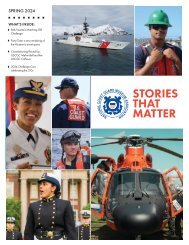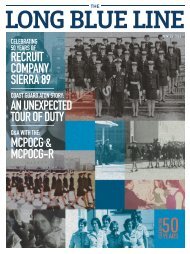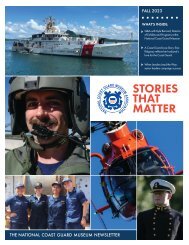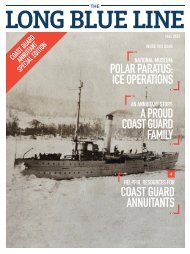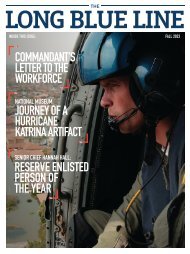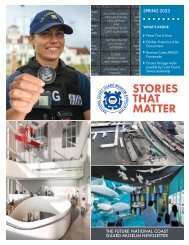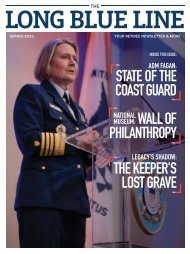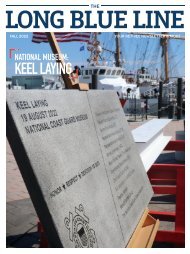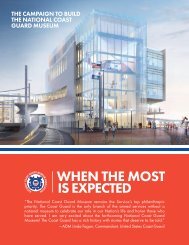The Long Blue Line (Winter 2021)
Quarterly magazine for retirees of the Coast Guard, Public Health Service, and National Oceanic and Atmospheric Association.
Quarterly magazine for retirees of the Coast Guard, Public Health Service, and National Oceanic and Atmospheric Association.
You also want an ePaper? Increase the reach of your titles
YUMPU automatically turns print PDFs into web optimized ePapers that Google loves.
Bobby<br />
Wilks<br />
COAST GUARD AVIATOR<br />
AND TRAILBLAZER<br />
William H. Thiesen, Ph.D., Atlantic Area Historian<br />
In the United States Coast Guard, there<br />
are thousands of highly motivated men<br />
and women doing extraordinary things.<br />
<strong>The</strong>se are the kind of personnel who have<br />
steered the Service throughout its 230-<br />
year history.<br />
<strong>The</strong> model example of such a Coast Guardsman<br />
was Bobby Charles Wilks, an African American<br />
who led the Coast Guard toward greater diversity<br />
in the post-World War II era by breaking color<br />
barriers for Coast Guard officers and blazing a<br />
trail for all minorities in the Service.<br />
Bobby Wilks was an overachiever, attending<br />
Stowe Teacher’s College in St, Louis, MO, and<br />
serving as president of his senior class. He was<br />
also head of the student choir and his fraternity,<br />
and captain of the college track team. Wilks went<br />
on to complete a master’s degree in education<br />
at Saint Louis University, learning the leadership<br />
skills he would later use in his career. A little over a<br />
year after completing his graduate degree, he had<br />
enlisted in the Coast Guard, received an officer’s<br />
commission, and earned his aviator wings through<br />
the flight school at Pensacola Naval Air Station.<br />
Wilks rose through the officer ranks and broke<br />
many Coast Guard color barriers. In 1956, he<br />
became the first African American to graduate<br />
from the post-World War II Officer Candidate<br />
School. In 1965, he became the first recognized<br />
African American to achieve a rank higher than<br />
lieutenant. Coast Guard predecessor service<br />
Captain Michael “Hell Roarin’ Mike” Healy, the<br />
son of a slave and a plantation owner, became<br />
a senior officer in the late-nineteenth century.<br />
However, Healy appeared to be Caucasian and<br />
he never admitted his racial background to others.<br />
On the other hand, Wilks was always recognized<br />
as a man of color.<br />
THE LONG BLUE LINE WINTER <strong>2021</strong><br />
25



